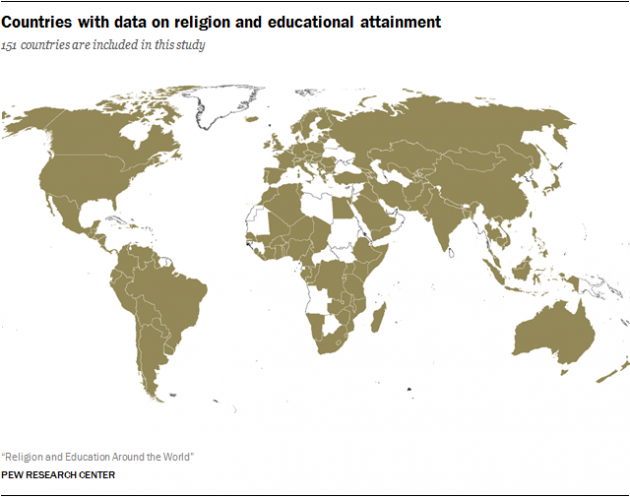Jews highest educated around world; Christians higher than Muslims in sub-Saharan Africa, study shows

Jews are more highly educated than any other major religious group around the world, while Muslims and Hindus tend to have the least years of formal schooling, a new study shows, revealing wide disparities in average educational levels among religious groups.
A Pew Research Center global demographic study shows that the gaps in educational attainment are partly a function of where religious groups are concentrated throughout the world.
http://www.pewforum.org/2016/12/13/religion-and-education-around-the-world/
For instance, the vast majority of the world's Jews live in the United States and Israel; both economically developed countries with high levels of education overall.
And low levels of attainment among Hindus reflect the fact that 98 percent of Hindu adults live in the developing countries of India, Nepal and Bangladesh, the 151 page report finds.
But there also are important differences in educational attainment among religious groups living in the same region, and even the same country.
In sub-Saharan Africa, for example, Christians generally have higher average levels of education than Muslims.
Some social scientists have attributed this gap primarily to historical factors, including missionary activity during colonial times.
The difference between Christian and Muslim educational attainment in sub-Saharan Africa is among the largest intraregional gaps in the world.
The region's rapid projected population growth – both Christians and Muslims in sub-Saharan Africa are expected to double in number by 2050 – suggests that determining the reasons for the attainment gap will only grow in importance.
Some scholars suggest that the source of the Christian-Muslim attainment gap is rooted in the location of Christian missionary activity during colonial times.
Missionary-built educational facilities were often located in what became heavily Christian areas rather than predominantly Muslim locales.
For example, while school establishment was widespread as a result of missionary activity in many regions under British colonial rule, in northern Nigeria, which is now overwhelmingly Muslim, British colonial administrators discouraged missionary activity, including development of missionary schools.
Historic differences between colonial policy and missionary activity in northern and southern Nigeria are likely an important factor in the present- day Christian-Muslim education gap in Nigeria.
Some Muslims, in any case, feared that missionary schools would attempt to convert their children to Christianity, the report says.
'CHRISITIANS GAINED EDUCATIONAL EDGE'
As a result, Christians gained an educational edge over Muslims that lasted decades.
Harvard economist Nathan Nunn who wrote "Gender and Missionary Influence in Colonial Africa." Finds that the presence of Christian missionaries, particularly Protestant missionaries, has been shown to be strongly correlated with increased educational attainment and the effects appear to persist for many generations.
In another study, of Christian versus Muslim primary school enrollment, Holger Daun, an expert in educational policy at Stockholm University, argues that religion counts as much as economic factors in determining attainment.
He finds no definitive explanation for the gap, but suggests that one factor may be that religious schools set up by local Islamic leaders are viewed as an alternative to government schools.
Some of the Islamic schools follow the curricula of State schools, while others teach only religious subjects.
Melina Platas, an assistant professor of political science at New York University-Abu Dhabi, argues that the Christian-Muslim attainment gap, particularly in Muslim-majority areas, is only partly explained by poverty and access to schools.
Surveys she conducted in Malawi found that Muslims and Christians express similar demands for formal education and do not perceive a trade-off between religious and formal schooling that would affect educational attainment.
She offers two alternative explanations for further research. One, she writes, is that parents with low levels of education are less able to help their children attend and succeed in school "even if they have similar expectations for the economic returns of schooling as more educated parents."
This intergenerational pattern may be stronger in Muslim-majority areas, where many parents have low educational attainment.
Overall the study, drawing on census and survey data from 151 countries, also finds large gender gaps in educational attainment within some major world religions.
For example, Muslim women around the globe have an average of 4.9 years of schooling, compared with 6.4 years among Muslim men. And formal education is especially low among Hindu women, who have 4.2 years of schooling on average, compared with 6.9 years among Hindu men.
Yet many of these disparities appear to be decreasing over time, as the religious groups with the lowest average levels of education – Muslims and Hindus – have made the biggest educational gains in recent generations, and as the gender gaps within some religions have diminished, according to Pew Research Center analysis.
The report was produced by Pew Research Center as part of the Pew-Templeton Global Religious Futures project, which analyzes religious change and its impact on societies around the world.
Funding for the Global Religious Futures project comes from The Pew Charitable Trusts and the John Templeton Foundation.